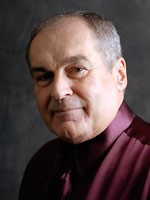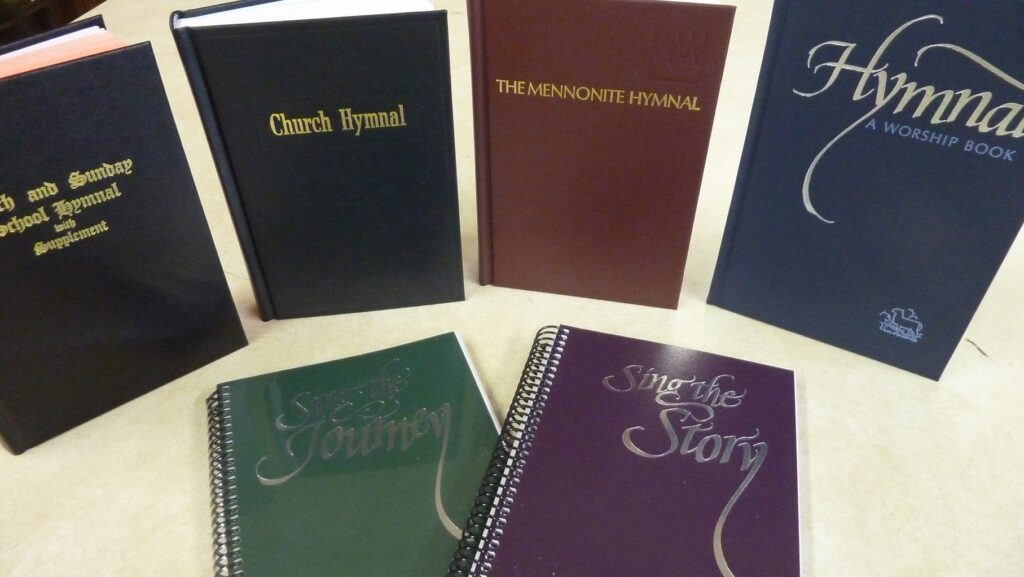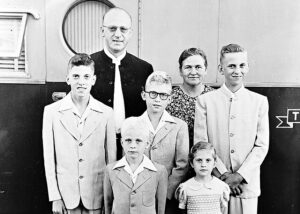Dr. Kenneth J. Nafziger, long-time and noted professor of music at Eastern Mennonite University—plus a key figure in putting together a hymnal and two song supplements—spoke at a recent breakfast meeting of the Eastern Mennonite University Anabaptist Center for Religion and Society. His topic: How our hymns influence and reflect our changing theology.
Former radio speaker Margaret Foth introduced Nafziger and reflected on memories of her mother singing—almost every morning—the familiar “I owe the Lord a morning song, of gratitude and praise. . . .” There were numerous affirmative nods around the room—obviously a similar remembrance for many.
As Nafziger got up to speak about the history of Mennonite hymnals, he first told a story of the origins of this “quintessentially Mennonite” hymn, written by Amos Herr, a Lancaster County (Pa.) bishop.
One Sunday morning, when the snow was so deep Amos’s horse couldn’t make it through the drifts to church, Amos wrote this song of gratitude. “It has been in every [Mennonite] hymnal since then,” he noted, a “simple and sturdy tune like Shaker furniture, with clearly conveyed ideas.”
This story reminded Nafziger of the time he took a group of Eastern Mennonite University students to southwestern Germany, an area from which the predecessors of many North American Mennonites hail. Some in that tour group were music students, and someone in a congregation they were visiting asked that they sing “I Owe the Lord a Morning Song.
“Many of the EMU students, youngsters that they are, didn’t know it!” So the German congregation sang it in English for the EMU students. The Europeans said that North American PAX and Civilian Public Service volunteers had taught them the song in the late ’50s and early ’60s.
He followed his story by launching the roomful of expectant listeners into a rich a cappella verse or two.
Nafziger gave a rundown of Mennonite hymnals in the U.S. (an admittedly incomplete history, he noted). Many of the old-timers in the audience remembered these titles, all published by Mennonite Publishing House or Herald Press. (The ones with links are still sold through the MennoMedia store.)
Below are 11 out of Nafziger’s list of 25 Mennonite hymnals in the U.S.:
1902- Church and Sunday School Hymnal
1916- Life Songs No. 1
1924- Children’s Hymns and Songs
1927- Church Hymnal
1938- Life Songs No. 2
1947- Junior Hymns
1969- The Mennonite Hymnal (from whence came the beloved hymn #606, Praise God from whom All blessings Flow)
1979- Sing and Rejoice
2005- Sing the Journey
2007- Sing the Story
1992- Hymnal: A Worship Book (co-published with Brethren Press for Mennonite and Church of the Brethren congregations)
Nafziger gave additional juicy one-liners about the difficult job of producing a new song collection that pleases everyone:
- The only thing wrong with a new hymn is that no one knows it yet.
- It is easy to “slide into ruts” in our music.
- The power of social singing—for the fun of it—is underestimated.
- No. 606 was put into a section of the 1969 hymnal with songs that were more difficult to sing. When its new number, #118 in Hymnal: A Worship Book (1992), was first announced in some venues, there were audible boos and hisses!
- New hymnals unleash new creativity by poets, pastors and musicians who want to publish new hymns they’ve written or composed.
- Many Mennonites remember the Medical Mission Sisters, a nuns’ group out of South America in the ’60s, which popularized folk-type music for Catholic worship.
- The “Old” Mennonite branch of the church did not traditionally use instruments; he remembers one Gospel Herald editor writing that a guitar was the perfect accompaniment for worship because it was “so cheap.”
- The first printing of Sing and Rejoice was withdrawn and destroyed because it had a stanza with the word “gay” in it.
- The hymn “How Great Thou Art” cost more to include than any other song, because of the copyright.
- The 1992 hymnal was the first Mennonite hymnal to be organized according to different acts or movements of worship, such as gathering, praise, thanksgiving. It was also the first hymnal with a section on “doubt.” Nafziger said people thanked him for helping to create a section on doubt in a hymnal.
Finally, Nafziger offered practical ideas and thoughts for using music in a congregation:
- Consider giving children or youth a hymnal upon baptism or confirmation.
- You can tell if a congregation’s singing is getting into ruts if one or more section of pages in the hymnal have edges that are well used or smudgy from hands.
- Always use a song from the global church in every service, as a reminder that we have an international church, and a reminder that the way we live in the world is different.
- Remember that congregants are often more moved by songs than by the sermon. Music moves words close to the heart and soul.
In early 2016 work on a new Mennonite song collection begins in earnest. The new hymnal project organizers are soliciting applications for paid staff (full- and part-time) and volunteers. See more information about “Project 606.”









Leave a Reply
You must be logged in to post a comment.